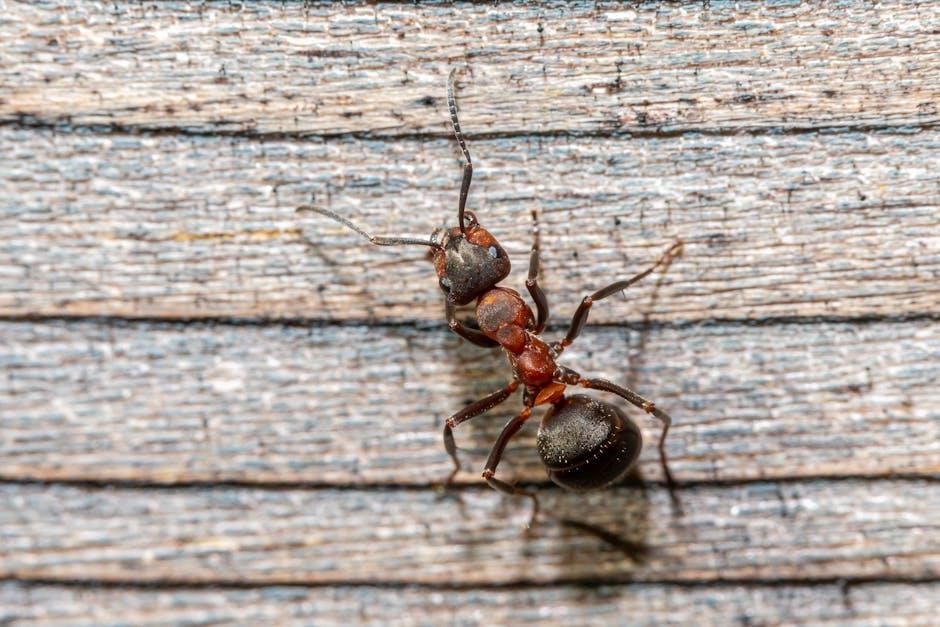Arkansas is home to diverse ant species, including invasive ones like the Asian needle ant. Understanding local ants is crucial for ecological balance and pest management.
1.1 Importance of Ant Identification in Arkansas
Accurate ant identification in Arkansas is vital for understanding their ecological roles and addressing potential threats. Invasive species like the Asian needle ant pose risks to health and ecosystems, while native ants contribute to seed dispersal and soil health. Proper identification aids in conservation efforts, protecting beneficial species and managing harmful ones. It also supports agriculture by distinguishing between pests and beneficial ants. Public health concerns, such as allergic reactions from stings, further highlight the need for precise identification. This knowledge enables effective pest control strategies and preserves ecological balance, making ant identification a critical tool for environmental and agricultural management in Arkansas.
1.2 Overview of Arkansas’s Ecosystem and Ant Diversity
Arkansas’s diverse ecosystems, ranging from forests to grasslands, support a wide variety of ant species. The state’s temperate climate and varied landscapes create habitats for both native and invasive ants. Forested regions host species like carpenter ants, while grasslands are home to harvester ants. Wetlands and agricultural areas also provide unique environments for different ant populations. This biodiversity underscores the importance of understanding Arkansas’s ant diversity, as it reflects broader ecological health. The presence of invasive species, such as the Asian needle ant, further emphasizes the need for awareness and conservation efforts to protect these critical ecosystems and their inhabitants.

Common Ant Species in Arkansas
Arkansas hosts a variety of ant species, including fire ants, carpenter ants, and the invasive Asian needle ant, each impacting ecosystems and human health uniquely.
2.1 Fire Ants (Solenopsis invicta)
Fire ants are highly invasive and common in Arkansas. Known for their painful sting, they form large colonies and are often found in disturbed soil areas. Their reddish-brown color and distinctive mounds make them easily identifiable. Fire ants are a significant concern due to their ability to spread rapidly and disrupt local ecosystems. They are also known to damage crops and electrical equipment. Controlling their populations is essential to protect both the environment and human health.
2.2 Carpenter Ants (Camponotus spp.)
Carpenter ants are among the largest ant species in Arkansas, typically black or dark brown in color. They are known for excavating wood to create nests, though they do not eat the wood itself. These ants are often found in moist, decaying wood and can cause significant structural damage over time. Carpenter ants are ecologically important, aiding in wood decomposition, but can also be pests when infesting buildings. Their size, color, and nesting habits make them distinct from other ant species in the region.
2.3 Harvester Ants (Pogonomyrmex spp.)
Harvester ants are notable for their seed-gathering behavior, playing a crucial role in seed dispersal and ecosystem balance. In Arkansas, they are commonly found in dry, sandy areas and are recognized by their reddish to dark brown color. These ants are medium-sized, typically ranging from 5 to 10 mm in length. They are known for their distinctive nesting habits, creating large, mound-like structures. Harvester ants are important ecological engineers, aiding in soil turnover and nutrient cycling. While they are generally beneficial, they can occasionally conflict with agricultural interests due to their seed-collecting activities.
2.4 Little Black Ants (Monomorium minimum)
Little black ants are one of the most common ant species in Arkansas, recognized by their shiny, dark black bodies and small size, typically 1.5 to 2 mm in length. They are highly adaptable, thriving in both urban and natural environments. These ants are known for their scavenging behavior, feeding on sweet liquids, oils, and small insects. Little black ants often form large colonies with multiple queens, making them resilient to disturbances. While they are not aggressive, they can become pests when invading homes in search of food. Their small size allows them to enter through tiny cracks, making them challenging to exclude;
2.5 Odorous House Ants (Tapinoma antennatum)
Odorous house ants are small, dark-colored ants, typically brown to black, measuring 1.5 to 3.5 mm in length. They are named for the distinctive rotten coconut-like odor released when crushed. These ants are highly adaptable and commonly found in Arkansas, thriving in both indoor and outdoor environments. They prefer sweet or sticky substances but will also consume proteins and fats. Odorous house ants often nest near moisture sources, such as near sinks or in damp soil. Colonies can be large, with multiple queens, and they are known for their trailing behavior when foraging. Their attraction to household food makes them frequent pests in homes;
2.6 Pavement Ants (Tetramorium caespitum)
Pavement ants are small, dark-colored ants, typically brownish-black, measuring 2.5 to 3.5 mm in length. They are recognized by their distinctive parallel ridges on the head and their habit of nesting in cracks in pavement, sidewalks, and building foundations. These ants are common in Arkansas, particularly in urban and residential areas. Pavement ants are known for their ability to infest structures, entering through cracks and crevices. Colonies are large, often with multiple queens, and workers forage in trails, feeding on a wide variety of food sources, including sweet liquids, proteins, and fats. They are most active during warmer months.

Physical Characteristics for Identification
Ants in Arkansas exhibit diverse physical traits, including color variation, size differences, and distinct body structures. Key features like antennae shape, mouthparts, and leg structure aid accurate species identification.
3.1 Color Variation Among Arkansas Ants
Ants in Arkansas display a variety of colors, aiding in identification. Common colors include red, black, brown, and yellow, with some species exhibiting a mix of hues. For instance, Fire Ants are typically reddish-brown, while Little Black Ants are dark brown or black. Harvester Ants often have a reddish-brown coloration. Color variation can also indicate caste or role within a colony, such as queens or males differing from workers. Understanding these color patterns helps in distinguishing species, as certain colors are associated with specific habitats or behaviors, making it a key trait for accurate identification. This diversity highlights the importance of observing color carefully.
3.2 Size Differences in Ant Species
Ant species in Arkansas vary significantly in size, which is a crucial factor for identification. For example, Carpenter Ants are among the largest, measuring up to 1/2 inch, while Little Black Ants are much smaller, typically around 1/8 inch. Fire Ants range from 1/8 to 1/4 inch, and Harvester Ants are usually between 1/4 to 1/2 inch. Size differences often reflect ecological roles, with larger ants like Pavement Ants (1/4 inch) being more robust for their underground habits. Observing size helps narrow down species and understand their behavioral adaptations. This variation underscores the diversity of Arkansas’s ant population.
3.3 Body Structure: Distinct Features
Ants in Arkansas exhibit distinct body structures that aid in identification. Most species have three body segments: head, thorax, and abdomen, connected by a narrow waist. The petiole, a characteristic feature, is especially noticeable in species like Carpenter Ants. Some ants, such as Odorous House Ants, have a rounded abdomen, while others, like Harvester Ants, may have spines or other protrusions. The shape and texture of the thorax can also vary, with some species displaying wing attachments. These structural differences are vital for distinguishing between species and understanding their ecological roles in Arkansas’s diverse habitats.
3.4 Antennae and Mouthparts
Antennae and mouthparts are critical for identifying Arkansas ants. Most species have elbowed antennae, a key distinguishing feature. The antennae’s shape, length, and segmentation vary, aiding in species differentiation. Mouthparts, such as mandibles, are adapted to diet: chewing mouthparts for solids and siphoning mouthparts for liquids. Some ants, like Harvester Ants, have strong mandibles for seed cracking, while others, like Odorous House Ants, have simpler structures for liquid food. These features reflect ecological roles and are essential for accurate identification, though expert examination is often required for precise classification.
3.5 Leg Structure and Movement
The leg structure of Arkansas ants varies, adapting to their ecological roles. Most species have three pairs of legs with distinct tarsal segments, enabling precise movement. Harvester Ants have robust legs for digging, while Carpenter Ants possess strong, clawed legs for navigating wood. Some species, like Little Black Ants, have slender legs for rapid movement. Leg hairiness and spur presence also differ, aiding identification. Movement patterns, such as slow and deliberate versus swift and erratic, further distinguish species. These traits, combined with other physical features, are vital for accurate identification in the field or lab, reflecting their unique behaviors and habitats.

Behavioral Traits for Identification
Behavioral traits like nesting habits, foraging patterns, and social interactions are crucial for identifying Arkansas ants. These traits often reflect species-specific adaptations to their environments and roles.
4.1 Nesting Habits of Arkansas Ants
Arkansas ants exhibit diverse nesting habits, reflecting their ecological roles. Fire ants construct large, mound-shaped nests in open areas, while carpenter ants excavate wood to create galleries. Odorous house ants often nest in moist, protected locations like wall voids or under debris. Harvester ants typically build nests in soil with small entrances, while little black ants prefer cracks in pavement or soil. Pavement ants nest under concrete or stones. Each species’ nesting behavior is adapted to its environment, ensuring survival and colony growth. Understanding these habits aids in identification and pest management strategies.
4.2 Foraging Behavior and Food Preferences
Arkansas ants display varied foraging behaviors and food preferences, shaped by their ecological roles. Fire ants forage in trails, feeding on sweet liquids, proteins, and small insects. Carpenter ants, active at night, seek sweet substances and live prey. Harvester ants uniquely gather seeds, while little black ants and odorous house ants favor sweet liquids and proteins, often invading kitchens. Pavement ants forage on sugary substances and small insects. Understanding these behaviors helps in identifying species and managing infestations effectively, as their food preferences often lead them into conflict with human activities and ecosystems.
4.3 Social Structure and Colony Life
Arkansas ants exhibit complex social structures, with colonies organized into castes: workers, soldiers, and queens. Workers handle foraging, nest maintenance, and care for young, while soldiers defend the colony. Queens focus on reproduction, ensuring the colony’s survival. Communication via pheromones is crucial for coordinating tasks. Colonies often have hierarchical structures, with varying levels of complexity depending on the species. Some species, like fire ants, form large, highly organized colonies, while others, such as harvester ants, maintain smaller, more specialized groups; Understanding these social dynamics aids in identifying species and managing their populations effectively in both natural and residential settings.
4.4 Seasonal Activity Patterns
Arkansas ants exhibit distinct seasonal activity patterns influenced by climate and species. In spring, colonies emerge from dormancy, with increased foraging and nest expansion. Summer sees peak activity, particularly for species like fire ants and pavement ants, as they forage intensively. Fall activity slows as ants prepare for winter by storing food and sealing nests. During winter, most species enter dormancy, reducing surface activity. Understanding these cycles aids in identifying species and timing control measures effectively. Observing seasonal behaviors can also help differentiate between invasive and native ant populations in various Arkansas ecosystems.

Habitat and Distribution
Ants in Arkansas inhabit diverse habitats, from urban residential areas to forested regions, grasslands, and wetlands. Their distribution varies by species, adapting to specific environmental conditions across the state.
5.1 Ants in Residential Areas
Ants are common invaders of residential areas in Arkansas, often entering homes in search of food or shelter. Species like the Little Black Ant and Odorous House Ant frequently infest kitchens and pantries, attracted to sweet or sticky substances. These ants typically nest in soil near buildings or within walls, especially in moist areas. Fire Ants are also prevalent in residential yards, forming large mounds that can be hazardous. Proper sanitation, sealing entry points, and maintaining a clean yard can help deter ants from invading residential spaces. Regular monitoring is key to preventing infestations.
5.2 Ants in Forested Regions
Arkansas’s forested regions support a diverse range of ant species, with Carpenter Ants and Leafcutter Ants being particularly abundant. These areas provide ample nesting sites, such as decaying wood and soil, allowing ants to thrive. Carpenter Ants often excavate wood to create elaborate nests, while Leafcutter Ants are known for their unique fungus-farming behavior. Forest floors also host smaller species like the Little Black Ant, which forage for food in leaf litter. The moist, shaded environment of forests creates an ideal habitat for many ant species, contributing to the state’s rich biodiversity and ecological balance.
5.3 Ants in Grasslands and Meadows
Grasslands and meadows in Arkansas provide habitat for various ant species, including Harvester Ants and Field Ants. These open areas offer abundant sunlight and diverse vegetation, ideal for foraging. Harvester Ants are particularly common, collecting seeds as their primary food source. Little Black Ants also thrive here, feeding on sweet liquids and small insects. The open terrain allows ants to build shallow nests or mound-like structures. Grasslands and meadows support a mix of annual and perennial ant species, adapting to the dynamic environment. Their presence contributes to seed dispersal and soil turnover, enhancing ecosystem health in these regions.
5.4 Ants in Wetland Areas
Wetland areas in Arkansas harbor unique ant species adapted to moist environments. Marsh Ants and Shore Ants are commonly found near water sources, where they construct nests in soggy soil or vegetation. These ants often feed on small aquatic insects and plant material. Wetlands provide a humid habitat, allowing colonies to thrive year-round. Their presence plays a role in decomposing organic matter and supporting aquatic food chains. However, flooding can disrupt their nests, forcing colonies to relocate. Wetland ants are resilient and quickly adapt to changing water levels, ensuring their survival in these dynamic ecosystems.
5.5 Ants in Agricultural Zones
Agricultural zones in Arkansas support a variety of ant species that thrive in cultivated landscapes. Harvester Ants and Field Ants are common, often nesting in soil near crops. These ants contribute to pest control by preying on harmful insects, reducing the need for pesticides. However, some species, like the Odorous House Ant, can invade agricultural fields and damage crops. Farmland provides ample food sources, such as seeds and plant residues, fostering large colonies. Farmers must balance the benefits of natural pest control with potential crop damage. Monitoring ant activity is essential for maintaining agricultural productivity in Arkansas.

Safety Precautions and Handling
When handling ants, wear gloves and protective clothing to avoid bites or stings. Use tools to minimize direct contact and avoid disturbing nests to prevent aggressive behavior.
6.1 Safe Handling of Ants
When handling ants, wear gloves and protective clothing to minimize bites or stings. Use magnifying tools or instruments to avoid direct contact. Move slowly and gently to prevent provoking aggressive behavior. Avoid disturbing nests, as this can trigger defensive actions. Keep a safe distance when observing colonies to reduce stress on the ants. Wash hands thoroughly after handling. For species like fire ants, exercise extra caution due to their painful stings. Avoid touching eyes or face during handling. Observing ants in their natural habitat is often safer than physical contact. Always prioritize caution to ensure both human and ant safety.
6.2 Protective Gear and Equipment
When interacting with ants, use protective gear to ensure safety. Wear thick gloves, long sleeves, and pants to prevent bites. Closed-toe shoes protect feet from stings. A face mask and safety goggles can shield against aggressive species. Use a magnifying glass or hand lens for observation without direct contact. A small, escape-proof container is useful for temporary specimen collection. Avoid using bare hands, especially with species like fire ants. Proper equipment minimizes risks and ensures a safe experience while studying or handling Arkansas ants.

Distinguishing Ants from Similar Insects
Ants differ from similar insects like termites and carpenter bees through distinct physical and behavioral traits. Ants have a narrow waist, elbowed antennae, and mandibles for chewing. Termites lack the narrow waist, have straight antennae, and mouthparts adapted for wood. Carpenter bees are larger, hairy, and resemble bees with wings for nectar collection. Ants often form colonies with caste systems and trail foraging, whereas termites live in colonies with different castes and use mud tubes. Carpenter bees are solitary and nest in wood without eating it. These differences aid in accurate identification.
7.1 Differences from Termites
Ants and termites are often confused but exhibit distinct differences. Ants have a narrow waist, elbowed antennae, and chewing mouthparts, while termites lack a narrow waist and have straight antennae. Ants are typically smaller, with varying colors, while termites are pale and soft-bodied. Ants build mound nests or colony networks, whereas termites create mud tubes for movement. Termites primarily consume wood, whereas ants forage for various food sources. These physical and behavioral differences help in distinguishing between the two insects in Arkansas ecosystems;
7.2 Differences from Carpenter Bees
Ants and carpenter bees are easily confused due to size and color similarities, but distinct differences exist. Carpenter bees are larger, hairy insects with a shiny, rounded abdomen, while ants are smaller, with a narrow waist and elbowed antennae. Carpenter bees are solitary, nesting in wood, and lack the social structure of ants. Ants are typically more agile and often seen in groups, while carpenter bees are slow-moving and solitary. These physical and behavioral traits help differentiate between the two, aiding in accurate identification in Arkansas ecosystems.

Control and Management
Effective ant control involves a combination of prevention, targeted treatments, and professional services to manage infestations and prevent future occurrences in Arkansas homes and landscapes.
8.1 Non-Chemical Control Methods
Non-chemical control methods are eco-friendly and effective for managing ant infestations. Sealing entry points with caulk or weatherstripping can prevent ants from entering homes. Regularly cleaning up food debris and spills reduces attractants. Removing standing water sources, such as pet water dishes or clogged drains, discourages nesting. Natural deterrents like cinnamon, vinegar, or lemon juice can repel ants. Using natural bait traps with borax and sugar solutions can eliminate colonies. Maintaining a clean and dry yard, free of debris, also helps deter ants. These methods are safe for the environment and can be combined for better results.
8.2 Chemical Control Options
Chemical control methods are often necessary for severe ant infestations. Insecticides like pyrethrins, permethrin, or fipronil can be effective. Baits containing slow-acting poisons, such as hydramethylnon, allow worker ants to return to the colony, killing the queen. Sprays and dusts can target nests directly, while perimeter treatments prevent re-infestation. Always follow label instructions and take safety precautions, such as wearing gloves and avoiding spraying near food or water. Professional exterminators may use specialized chemicals for large-scale infestations. Chemicals should be used judiciously to minimize environmental impact and avoid harming beneficial insects.
8.3 Professional Pest Control Services
Professional pest control services offer expert solutions for ant infestations, providing tailored treatments based on species identification. Licensed exterminators use advanced techniques, such as targeted injections into nests or wall voids, ensuring effective eradication. They often employ eco-friendly options and adhere to safety regulations. Regular follow-up visits are typically included to prevent re-infestation. Hiring professionals is especially beneficial for large or persistent infestations, as they possess the knowledge and tools to address the root of the problem efficiently. Their services also come with warranties, offering peace of mind for homeowners and businesses.

Conservation and Ecological Role
Ants are vital to Arkansas’s ecosystems, aiding in soil turnover and seed dispersal. Conservation efforts protect these beneficial insects, ensuring ecological balance and biodiversity.
9.1 Ecological Importance of Ants
Ants play a crucial role in Arkansas’s ecosystems by contributing to soil health, seed dispersal, and nutrient cycling. Their underground colonies aerate soil, improving water infiltration and root growth. Certain species, like harvester ants, help spread plant seeds, while others act as natural pest controllers. Ants also serve as a food source for birds, reptiles, and small mammals. Their ecosystem engineering activities, such as nest construction, create habitats for other organisms. Additionally, ants aid in decomposing organic matter, recycling nutrients back into the environment. Their ecological significance underscores the importance of preserving these insects to maintain biodiversity and ecosystem balance in Arkansas.
9.2 Conservation Efforts in Arkansas
Conservation efforts in Arkansas focus on protecting ant habitats and reducing threats like habitat loss and pesticide use. Initiatives include preserving natural areas and promoting sustainable land management practices. Educational programs raise awareness about the ecological value of ants, encouraging reduced pesticide use and responsible landscaping. Collaboration between universities, wildlife agencies, and conservation organizations supports research and outreach. Protecting ant diversity is essential for maintaining healthy ecosystems, and these efforts ensure the long-term survival of Arkansas’s ant species.

Additional Resources
Explore field guides, online databases, and research institutions for detailed ant identification and ecological insights specific to Arkansas.
10.1 Recommended Field Guides
For accurate identification of Arkansas ants, several field guides are highly recommended. “Ants of North America: A Guide to the Genera” by Brian L; Fisher and Stefan P. Cover is a comprehensive resource. “The Ants” by Bert Hölldobler and E.O. Wilson provides in-depth ecological insights. The University of Arkansas Cooperative Extension Service publishes state-specific guides. Additionally, “Field Guide to the Ants of New Mexico” by Andrea Lucky is useful for neighboring regions. These guides offer detailed descriptions, color plates, and habitat information, making them indispensable for both casual observers and researchers. They are available online or in local libraries across Arkansas.
10.2 Online Resources and Databases
For identifying Arkansas ants, online resources like BugGuide.net and AntWiki provide detailed species profiles and images. The University of Arkansas Cooperative Extension Service offers fact sheets on common ant species. iNaturalist allows users to upload observations for expert identification. The USDA database includes invasive species information, while the Arkansas Natural Heritage Commission provides data on rare ants. These platforms are essential for accurate identification and understanding ant ecology in Arkansas, offering accessible and reliable information for researchers and enthusiasts alike.
Understanding Arkansas’s diverse ant species is crucial for ecological balance and pest management. This guide provides essential tools for identification and responsible ant management practices.
11.1 Summary of Key Identification Points
Identifying Arkansas ants requires observing physical traits like color, size, and body structure. Fire ants have distinctive red and black coloring, while carpenter ants are larger with rounded abdomens. Harvester ants are recognized by their robust bodies and strong mandibles. Little black ants and odorous house ants are smaller, with the latter emitting a coconut-like odor when crushed. Pavement ants have parallel lines on their heads. Antennae shape and leg structure also aid in identification. Behavioral traits, such as nesting habits and foraging patterns, further distinguish species. Understanding these characteristics is essential for accurate identification and effective ant management in Arkansas.
11.2 Final Thoughts on Ant Identification
Accurate ant identification in Arkansas is crucial for understanding their ecological roles and managing infestations. By focusing on physical traits like color, size, and body structure, as well as behavioral patterns, anyone can effectively distinguish between species. This knowledge not only aids in pest control but also fosters appreciation for these insects’ importance in the ecosystem. Continuous learning and observation are key to mastering ant identification. Remember, each species, from fire ants to harvester ants, plays a unique role in Arkansas’s biodiversity. Embrace the opportunity to explore and learn more about these fascinating creatures and their contributions to nature.
